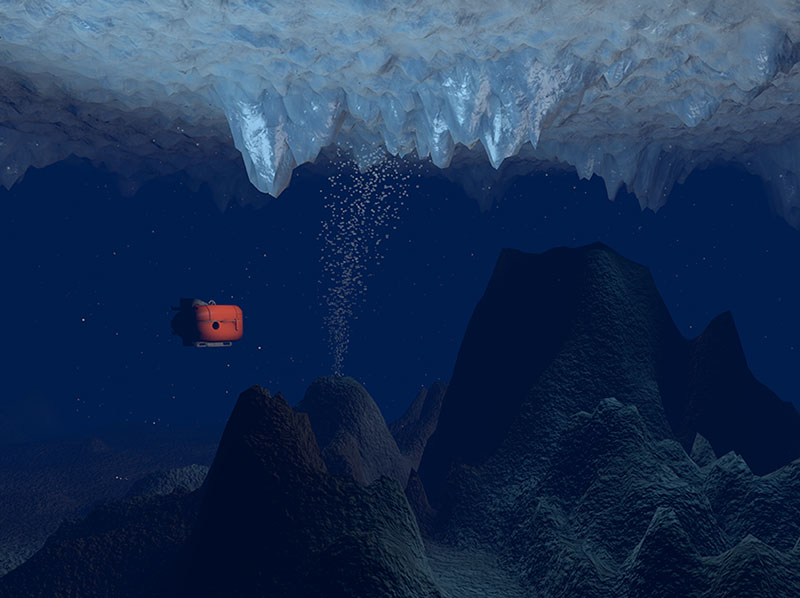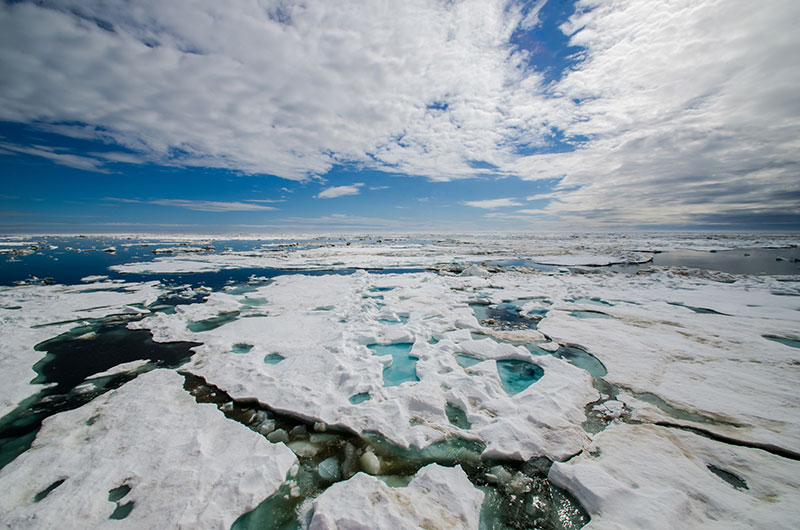
September 19-October 16, 2019

Artistic rendition of Nereid Under Ice exploring for hydrothermal vents in the ice-covered Arctic. Illustration of Woods Hole Oceanographic Institution. Download larger version (jpg, 4.3 MB).
A team of oceanographers are heading out on a voyage of discovery this month, exploring in detail for the first time a hydrothermal vent field in the Arctic Ocean. They are hoping to find some of the same geological, chemical, and biological processes at the Gakkel Ridge, an ultra-slow spreading rift system north of Greenland that also may be underway on outer worlds of our solar system.
Many scientists now believe that if we want to find extraterrestrial life, the best place to look for it might be somewhere in the ice-covered oceans of Europa, Enceladus, or another moon of Jupiter, Saturn, or Neptune. They believe the same brew of geological and chemical conditions that might host primitive life at the bottom of the ice-covered Arctic may also be at work on these alien worlds. Ocean scientists and engineers are today conducting a dry run of sorts for the kind of mission that NASA’s planetary scientists may launch in coming decades to in order to search for life beyond Earth.
Chris German, a senior scientist at the Woods Hole Oceanographic Institution , has explored hydrothermal vent fields across many oceans for the past 30 years. As he prepares to serve as co-principal investigator on this upcoming mission, he sees a chance for new discoveries here on Earth, and perhaps on the oceans of other worlds as well.
“These interplanetary oceans are too far from the sun for photosynthesis, but there’s no reason why they can’t have chemosynthesis,” says German, a co-principal investigator for the HACON (Hot Vents in an Ice Covered Ocean) expedition .

The beautifully dramatic landscape of the ice-covered Arctic will be the backdrop for the mission. Image courtesy of Caitlin Bailey, GFOE, The Hidden Ocean 2016: Chukchi Borderlands. Download larger version (jpg, 4.8 MB).
The expedition team of 37 geologists, geochemists, physical oceanographers, micropaleontologists, microbiologists, ecologists, engineers, and NASA astrobiologists departs Svalbard, Norway, on September 19 aboard the R/V Kronprins Haakong . The Norwegian polar research icebreaker was completed in April 2018 and is jointly owned by the University of Tromsø, the Norwegian Polar Institute, and the Norwegian Institute of Marine Research. The NOAA Office of Ocean Exploration and Research is supporting German’s research, while science agencies from Norway, Germany, and Portugal are sponsoring the HACON expedition.
German says there’s a direct link between the science and technology that will be deployed on this cruise in the Arctic and the methods that NASA will deploy when the agency puts an orbiting spacecraft (and eventually a lander) around Jupiter’s moon Europa.
“All the skills we have developed to explore cold seeps and hydrothermal vents here might have an impact on exploring space in the future,” German says.

During the expedition, one of the tools the team will use to explore is the hybrid remotely operated vehicle Nereid Under Ice. This rendering shows the vehilce working on the underside of overlying ice. Illustration by Casey Machado, Woods Hole Oceanographic Institution. Download larger version (jpg, 1.6 MB).
The HACON cruise includes unique undersea instruments to explore the 4,000-meter deep hydrothermal vent field, including WHOI’s Nereid Under Ice (NUI) , a special hybrid remotely operated vehicle (HROV) that can operate up to 40 kilometers (24.85 miles) beneath sea ice without a tether and which has been upgraded – new for this expedition – to be able to dive down to 5,000 meters (3.11 miles) deep. The Gakkel Ridge is an underwater bridge of sorts between the Atlantic and Pacific Oceans, and scientists like German expect that its location may be home to new kinds of marine life that lie undiscovered.
The expedition team will survey the seafloor with high-resolution sonar technology, while collecting temperature readings and trace signatures of chemicals like methane that can be used to reveal the location of the vents. Researchers also want to conduct an ecological study of the vent field, bringing up samples to identify in the ship’s on-board laboratory.
German sees the HACON cruise as part of a continuous line of research that will lead to science’s ultimate prize: “This is our best chance to answer whether there’s life beyond Earth in our lifetime,” he says.